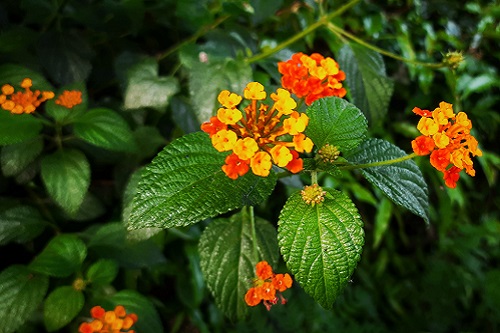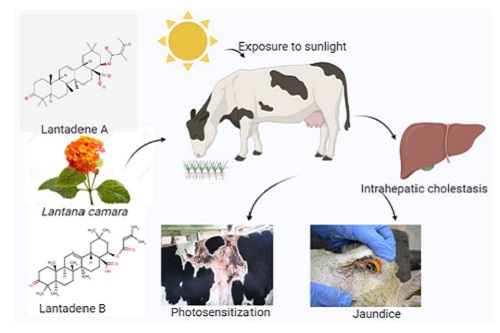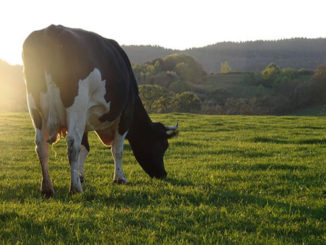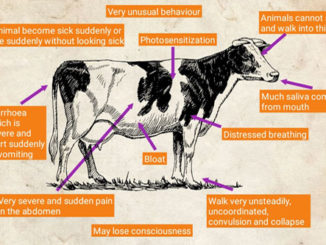With their flamboyant flowers of vibrant colour combinations, Lantana never ceases to catch our attention, by making our barren lands, roadsides, orchards, and forests colourful. But behind that luxurious foliage and vibrant flowers, hides the story of an evasion that killed various native flora, wild and domestic animals.
Lantana camara
Lantana camara, belonging to the family Verbenaceae, comprises about 100 genera with around 2600 species that are distributed in the tropical, subtropical, and temperate regions. Lantana is dispersed all over the world as an invasive species and poses significant ecological and economic impact. As flowers of the plant are radiant, lantana, native to central and south America was introduced as an ornamental plant, later colonized and naturalized in most of the countries including India. Along with a threat to biodiversity, lantana is also considered one of the top ten toxic plants affecting livestock. There are five main flower colour varieties of the weedy form of L. camara, with the red flower variety being most toxic to animals. Lantana adversely affects animal husbandry activities in two ways- by causing significant morbidity and mortality in livestock, and loss of forage due to allelopathic action. Lantana can be rapidly propagated by cuttings or stumps, and in natural conditions, they are spread by the seeds disseminated by a variety of birds in their droppings.

What causes the toxicity in animals?
The toxic principles of the plant are pentacyclic triterpenoids called lantandenes. Lantadene A (LA), lantadene B (LB), lantadene C (LC), and lantadene D (LD) are the major constituents and reduced lantadene A (RLA) and reduced lantadene B (RLB) are the minor constituents. In normal conditions, animals wouldn’t prefer to graze the plant. But in special circumstances like scarcity of fodder, new animals introduced to an area where Lantana is present, etc, animals may ingest the leaves and get intoxicated. The toxins are mainly present in the leaves of the plant. The concentration of lantadenes in the plants varies with different geographical locations, stages of growth, and climatic conditions. Toxicity has been reported in various domestic animals like cattle, buffalo, sheep, and goats, with the latter being least susceptible.
How does the toxin affect the animal?
Lantadenes produce intrahepatic cholestasis in animals resulting in secondary photosensitization. When the animal ingests lantana leaves, the toxins present in the leaves get absorbed into the bloodstream mainly from the small intestine. As time passes, the contents become more liquid, and the absorption increases. The toxins are transported through the portal blood to the liver and exert their toxic effect through various mechanisms that are yet to be elucidated. Various experiments conducted on guinea pigs and sheep indicate intrahepatic cholestasis and paralysis of the gall bladder. This aberration in the bile secretion results in the accumulation of phylloerythrin in the circulation. Phylloerythrin is a natural biodegradation product of chlorophyll, that gets excreted normally via bile. When the bile excretion is disrupted the phylloerythrin accumulates in the blood, which results in photochemical reactions on exposure to sunlight and photosensitization.

What happens if the animal ingests lantana leaves?
The toxicity is manifested in 3 phases. The gastro-intestinal phase where the toxin is absorbed, the hepatic phase where biliary excretion is disrupted, and the post-hepatic phase where secondary photosensitization happens. The affected animals may show symptoms of jaundice, like an icteric mucous membrane. They will stop taking feed after a couple of hours of ingestion. There may be ruminal stasis and constipation which will further aggravate the condition by increasing the absorption of toxins from the gastrointestinal tract. Light-skinned areas of the skin typically show signs of photosensitization on exposure to sunlight. There may be swelling of eyelids, fissures on the muzzle, and other non-hairy parts of the body. There are case reports in which flocks of sheep, cattle, goats, and other livestock were affected and, in many cases, succumbed to death. Timely treatment by a veterinarian can save the lives of your animal.
Post-mortem examination of a lantana poisoned animal will reveal jaundiced subcutaneous tissue and visceral organs. The liver will be enlarged with ochre, yellow, or orange colour. Adrenals will be enlarged with thickened cortex.
Research data from experimental animals
Decades of research on the harmful effects of lantana on livestock elucidated the toxic principles, biotransformation of the toxins inside the body, and toxico-pathological changes in various systems. The preferred lab animal for research on lantana is guinea pigs. Findings on long-term lantana consumption indicate the possibility of renal failure in addition to liver damage. There are reports where chronic consumption is linked with chances of abortion and low production parameters. Elevation of various enzymes like serum bilirubin and alanine aminotransferase are consistent findings that will aid in the diagnosis of poisoning cases. Elucidation of various biochemical and molecular changes in response to the toxicity had helped the clinicians to frame a better therapeutic regimen. The therapeutic efficiency of various herbal agents in ameliorating lantana-induced cholestasis was studied extensively.
Measures for prevention and control of poisoning
The best way to protect your animal from getting poisoned is to prevent the access of lantana to the animal. When the animal is let for grazing, make sure it is not consuming lantana leaves. The invasion of lantana plants is of great concern from an ecological point of view. It is considered a threat to biodiversity in many countries including India, where the government is trying to control the invasion by various measures and policies. Young animals tend to consume the leaves as they have not developed an instinct to avoid them. Cases are also reported when animals are transported where they get access to feed lantana that is growing luxuriantly on roadsides.
The first thing to do if a skin lesion appears is to keep the affected animal in a well-shaded area. Further exposure to sunlight will worsen the skin lesions. Approach a veterinarian for the treatment of jaundice and skin lesions. Only symptomatic treatment is available for the condition. Hepatoprotective agents are used for enhancing the functioning of the liver. Administration of purgatives may hasten the elimination of the gastrointestinal contents.
Lantana as an ecological threat
Lantana can displace native species of plants by blocking their succession in a forest ecosystem. They exert an allelopathic effect on the surrounding flora, resulting in their diminished growth. Not only it is a threat to biodiversity, but also it limits the availability of forage to wild animals and livestock. Lantana has also got secondary impacts as it harbours various vectors spreading deadly diseases like malarial mosquitoes in India and tsetse flies in Africa. Many countries have employed sporadic control measures including chemical, cultural, mechanical, and biological methods to destroy lantana. Despite being a challenge to the livestock, various parts of the plant possessing biological activities are used in traditional medicinal practices.
Prospects
Various methods like vaccination and aversion therapy were investigated as prevention strategies against lantana toxicity in cattle. As a long-term solution to the problem, scientists are investigating various methods for the biodegradation of lantadenes with modification of ruminal microflora using various microbes like Pseudomonas picketii and Alcaligenes faecalis. Efforts have to be made to devise effective therapeutic strategies to prevent economic losses due to livestock death and production loss. Current control strategies are not yet effective to prevent the invasion of species in forest ecosystems and barren lands. Despite its enchanting beauty, lantana continues its invasion, marking new territories yet challenging to control.
For further reading
- Kumar, R., Sharma, R., Patil, R.D., Mal, G., Kumar, A., Patial, V., Kumar, P. and Singh, B., 2018. Sub-chronic toxicopathological study of lantadenes of Lantana camara weed in Guinea pigs. BMC veterinary research. 14(1), p.129.
- Pass, M.A., 1986. Current ideas on the pathophysiology and treatment of lantana poisoning of ruminants. Australian Veterinary Journal, 63(6), p.169-171.
- Sharma OP, Makkar HPS, Dawra RK. 1988. A review of the noxious plant Lantana camara. Toxicon. 26:975-987
- Sharma OP, Sharma S, Pattabhi V, Mahato SB, Sharma PD. 2007. A review of hepatotoxic plant Lantana camara. Crit. Rev. Toxicol. 37:313-352.
| The content of the articles are accurate and true to the best of the author’s knowledge. It is not meant to substitute for diagnosis, prognosis, treatment, prescription, or formal and individualized advice from a veterinary medical professional. Animals exhibiting signs and symptoms of distress should be seen by a veterinarian immediately. |








1 Trackback / Pingback